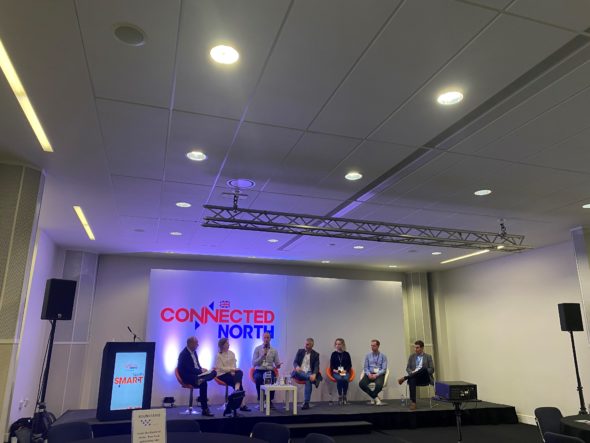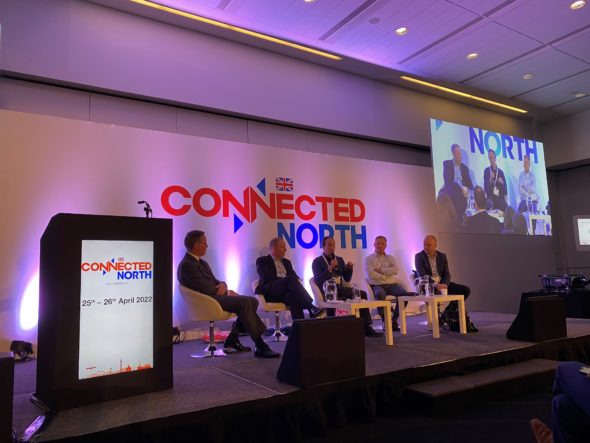
In Manchester last month, the inaugural Connected North kicked off with a bang. The event was held in Manchester Central as part of Manchester Tech week and put the North firmly in the spotlight. First, Matt Yardley, managing partner at Analyst Mason, moderated the opening keynote panel examining Gigabit North.
The panelists were Shaun Gibson, chief executive officer, Telcom, Matthew Hemmings, managing director of fibre and network delivery, Openreach, Greg Mesch, chief executive officer, CityFibre, Paul Kells, director of network strategy and engineering, Virgin Media O2 and Paul Norris, chief executive, Building Digital UK (pictured above).
Norris gave an update on how the government sees progress to connectivity infrastructure in the North. He said, “As a public body, our KPIs look a bit different from the network builders here. But ultimately, we’re here to deliver for the premises that need subsidies to take us to 85 per cent coverage across in the UK by 2025.
“In the North, that translates into KPIs for premises passed through our subsidies. In total, in the North, we currently model around 900,000 premises as being in scope for that subsidy over the duration of the programme.
“As of today, procurements have 130,000 premises contained within them so, in terms of the procurements we have launched, we are about 15 per cent of the way there. This is still early days. It’s a long game. But we are accelerating fast.”
Yardley asked the panellists about the “elephant in the room”: overbuild. He added, “This begs this question about sustainability for the business models we see today. There is a second question which relates to wholesale. There is a prospect of three wholesale networks in the same geographic area.”
Hemmings, from Openreach, said, “We welcome competition. If you look at what it has done for the UK market, the UK has some of the most competitive broadband prices in Europe and if you look at the speed of the gigabit rollout across the UK, it is arguably one of the fastest in the world when you combine what everybody is doing.
“Competition at the infrastructure layer is very positive. In Openreach, we are primarily focused on what we are doing. We have a plan to get to 25 million homes and we will be focusing on what we think is the most commercially viable footprint across the UK, including rural areas.
“We welcome [competition] and we support it through PIA, as well as getting on with building up our own footprint.”
CityFibre’s Mesch added, “The benefit of competition is right here on this panel. Anybody that has been in this industry for a decade has witnessed the massive investments by Virgin and Openreach, and they had not been making those because a challenger was not in the market.
“When CityFibre started investing in pure fibre, the rest of the market started to respond – that’s a wonderful thing. It should be an open market and competition should thrive. All of our customers can buy speeds at better value and at better prices, with better availability and better service levels. If we don’t provide that, we don’t exist.”
Progress and opportunity
Next, Sophie Barley, editor of ChronicleLive chaired a mayoral panel discussion between Cllr Bev Craig, leader of Manchester City Council, Steve Rotheram, Metro Mayor for the Liverpool City Region Combined Authority, and Tracy Brabin, Mayor of the West Yorkshire Combined Authority.
Rotheram discussed the opportunity for the so-called “Northern Corridor” around the M62 to thrive in this new era of connectivity. “It could be much more powerful than the golden triangle [the nickname for the triangle formed by the university cities of Cambridge, London and Oxford in the southeast of England]. And if the government is serious about levelling up, then the ability for us [Northern cities] to get some of that R&D in the North of England would mean that the real winner is UK plc.”
The event also included a session about digital innovation and the role advanced digital infrastructure can play in driving employment in key northern industries. The participants were Gareth Elliott, director of policy and communications, Mobile UK, Claire Delahunty, ambassador, ITS Technology Group, Sophie James, head of telecoms and spectrum policy, techUK, Lee Hargadon, head of enterprise and public sector for the UK and Ireland, Nokia, Jon Burt, lead enterprise architect, Greater Manchester Combined Authority, Will Ennett, head of sustainability, TalkTalk, and Chris Chambers, deputy director geospatial commission, Cabinet Office (pictured below).

James, from techUK, emphasised the range of technologies that will facilitate better connectivity in the North. “When we talk about digital infrastructure, we’re talking about quite a wide range of technologies starting with fibre, which is a key part of the backbone, and also mobile, which is going in really interesting directions – not just public networks, but also that private network piece.
“Beyond that, satellite is going to be interesting over the next decade.”
Chambers, from the Cabinet Office, discussed the opportunities created by government plans to build sustainable career pathways outside of London. He said, “There is a lot of discussion about Levelling Up, but no one is really talking about the Places for Growth agenda, which is a government agenda to get people out of London.
“22,000 civil servants will be out of London by the end of the decade, and that’s about trying to make sure those types of jobs aren’t just in London. The drain down to London is obvious, and this is about trying to keep high skilled jobs up North. Keeping the best people up here. And also to get people away from London so they can have the lifestyle up here.”
He added that this shift will be a massive challenge, but is also “a really big opportunity for the North of England to take those [highly skilled] jobs”
The discussion also touched on the importance of private companies collaborating with local authorities to meet the connectivity needs of businesses and people in local areas. ITS Technology Group’s Delahunty was asked whether ITS’ joint venture contract in the Liverpool city region is something that could be copied elsewhere in the country.
She said, “The alignment with that local authority gave us a unique perspective, and they have that longer-term outlook. It is a very replicable model. What ITS can bring is that commercial flexibility to respond to the individual needs of [local authorities]. And Liverpool City Region [added insight around the area’s] unique attributes and priorities, sectors, and growth.
“That combination of public and private sector know-how works really well. And Liverpool is a prime example of that.”
Advancing Project Gigabit
Another notable session was a discussion between operators about how they have been advancing on Project Gigabit in the North. James Saunby, vice chair, I.N.C.A. moderated the session, with Conal Henry, founder and chair, Fibrus, Daren Baythorpe, chief executive officer, ITS Technology Group, John McCabe, head of business development, Hyperoptic, and Richard Tang, founder and chairman, Zen Internet, participating (pictured below).

Tang explained how the connectivity landscape is changing. He said, “When we started in the mid-90s, the internet really was just a peculiarity for techies. Then in the late 90s, early 2000s, there was a plethora of internet service providers popping up all over the country, a lot of them in London.
“Over the course of the next decade, one by one the market consolidated, and we ended up with there not being very many left. I think we’re in a situation now where we’re looking at a very similar thing.
“We’ve gone through dial-in, ASL, FTTC, and now FTTP, and a lot of people in the industry realise that this is the last big infrastructure build in our lifetimes. Once a customer has got FTTP, you don’t need to dig up the streets anymore, you can go from 1Gbps to 10Gbps to 100Gbps to 400Gbps just by changing the optics and the kit.
“So, there is this huge rush to build fibre, but I expect there will be a lot of consolidation in the market. By the end of the decade, we’ll probably end up with a few big players and those will be with us forever.”
He added that questions around where to build and addressing overbuild will be the key questions for the industry in the near-term.
Henry, from Fibrus, was asked whether competition is a good thing in driving forward connectivity infrastructure projects in the North, and how industry can solve the question of who is going to pay for these deployments.
He said, “Competition is good for the market, it’s good for society. There is enough money in broadband subscriptions to pay for broadband investment, the issue is phone companies and TV companies have lived off supernormal profits for too long, so they expect an ROI that is just not there.
“If you accept a lower level of return over a longer period, broadband subscriptions are enough to generate broadband investment.”
Hyperoptic’s McCabe added, “We wouldn’t all be in this room if there was no competition. I’m old enough to remember when it was only BT, so I’ve seen the evolution and the benefits of competition. Without competition, the consumer ends up being dictated to in terms of price and service levels.”
McCabe might have been talking about consumers, but the message is the same for the channel. Competition drives fairness and progress.
